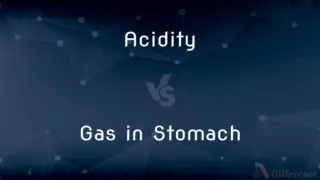Red Antifreeze vs. Green Antifreeze — What's the Difference?
Edited by Tayyaba Rehman — By Fiza Rafique — Published on November 11, 2023
Red Antifreeze (OAT) uses organic acid technology, lasting longer. Green Antifreeze (IAT) uses inorganic additives, requiring more frequent changes.

Difference Between Red Antifreeze and Green Antifreeze
Table of Contents
ADVERTISEMENT
Key Differences
Red Antifreeze, also known as Organic Acid Technology (OAT) antifreeze, is a modern coolant formulated without the use of silicates. It uses organic acid compounds to prevent corrosion and is designed for extended service life. This type of antifreeze tends to last longer than its green counterpart, often recommended for 5 years or 150,000 miles before needing a replacement. On the flip side, Green Antifreeze is the traditional coolant, known as Inorganic Additive Technology (IAT) antifreeze. It employs inorganic compounds and silicates to protect the engine from corrosion.
The primary distinction between Red Antifreeze and Green Antifreeze lies in their chemical compositions and service life. While Red Antifreeze is formulated for newer vehicles and longer intervals between changes, Green Antifreeze is typically for older vehicles, requiring more frequent maintenance – usually every 2-3 years or 30,000 to 40,000 miles.
Furthermore, Red Antifreeze tends to be more compatible with aluminum parts, commonly found in modern engines. It's essential, however, not to mix different types of antifreeze without consulting the vehicle's manual or an expert, as mixing Red Antifreeze and Green Antifreeze can lead to reduced efficiency and potential damage.
In summary, while both Red Antifreeze and Green Antifreeze serve the same primary function – cooling the engine and preventing freezing or overheating – they differ in their chemical compositions, service life, and recommended usage. Proper maintenance and adherence to manufacturer's recommendations are crucial regardless of the type used.
Comparison Chart
Chemical Composition
Organic Acid Technology (OAT)
Inorganic Additive Technology (IAT)
ADVERTISEMENT
Service Life
Longer (often 5 years/150,000 miles)
Shorter (typically 2-3 years/30,000-40,000 miles)
Compatibility
More compatible with aluminum parts
Works well with older engine designs
Color
Red/Pink/Orange variants
Green
Additives Used
Organic acids
Silicates and inorganic compounds
Compare with Definitions
Red Antifreeze
Extended-life coolant without silicates.
Many drivers prefer Red Antifreeze due to its longer service intervals.
Green Antifreeze
The standard coolant for many older vehicle models.
Before modern formulations, Green Antifreeze was the go-to choice for most drivers.
Red Antifreeze
Coolant designed for modern vehicle specifications.
Check the manual before using Red Antifreeze to ensure compatibility.
Green Antifreeze
Coolant with a service life of 2-3 years.
It's vital to replace Green Antifreeze every few years to maintain its effectiveness.
Red Antifreeze
A formulation compatible with aluminum parts.
For engines with aluminum radiators, Red Antifreeze is often the suggested coolant.
Green Antifreeze
A coolant requiring more frequent maintenance intervals.
If using Green Antifreeze, regular coolant checks are essential.
Red Antifreeze
An organic acid-based coolant for modern engines.
The new SUV models recommend using Red Antifreeze for optimal performance.
Green Antifreeze
A traditional coolant using inorganic additives.
Classic cars often require Green Antifreeze for optimal engine health.
Red Antifreeze
A long-lasting antifreeze variant reducing maintenance frequency.
Switching to Red Antifreeze helped me reduce the number of coolant changes.
Green Antifreeze
An inorganic, silicate-based engine coolant.
Many older vehicles still run efficiently on Green Antifreeze.
Common Curiosities
Is Red Antifreeze compatible with all vehicles?
No, it's primarily designed for specific models and makes, often European vehicles. Always refer to the vehicle's manufacturer's recommendations.
Can I mix Red Antifreeze with other colors?
Mixing different colors can lead to reduced efficiency, gel formation, or even engine damage. It's best to avoid mixing.
How long does Red Antifreeze last?
Typically, it can last up to 5 years or 150,000 miles, but it's essential to check the manufacturer's guidelines.
What is Red Antifreeze?
Red antifreeze is a type of engine coolant with a red or pink hue, formulated with organic acid technology (OAT).
Why is organic acid technology (OAT) significant in Red Antifreeze?
OAT provides extended protection for aluminum and other engine components against corrosion.
What are the benefits of using Red Antifreeze?
It generally provides extended protection against rust, corrosion, and cavitation without requiring frequent changes.
How long does Green Antifreeze last?
It usually lasts up to 2 to 3 years or 36,000 miles, requiring more frequent changes than newer formulations.
Is Red Antifreeze toxic?
Yes, like other antifreeze types, it is toxic and should be kept away from children and pets.
What is Green Antifreeze?
Green antifreeze is a traditional type of engine coolant, often formulated with inorganic acid technology (IAT).
What vehicles use Green Antifreeze?
Older vehicles, primarily those manufactured before the 2000s, commonly use green antifreeze.
Is it safe to mix Green Antifreeze with other types?
Mixing different antifreeze types can cause problems. It's recommended to stick with one type or flush the system before changing.
Does Red Antifreeze protect against boiling and freezing?
Absolutely, it helps regulate the engine's temperature, preventing both boiling in hot conditions and freezing in cold conditions.
Is it environmentally friendly?
While it may be less harmful than some older antifreeze formulas, it's essential to dispose of it properly and never release it into the environment.
How often should I change Red Antifreeze?
Typically, every 5 years or 150,000 miles, but always consult your vehicle's manual.
Does it protect against corrosion?
Yes, but its protection doesn't last as long as newer formulations, requiring more frequent replacement.
Share Your Discovery

Previous Comparison
Acidity vs. Gas in Stomach
Next Comparison
Activated Sludge vs. Primary SludgeAuthor Spotlight
Written by
Fiza RafiqueFiza Rafique is a skilled content writer at AskDifference.com, where she meticulously refines and enhances written pieces. Drawing from her vast editorial expertise, Fiza ensures clarity, accuracy, and precision in every article. Passionate about language, she continually seeks to elevate the quality of content for readers worldwide.
Edited by
Tayyaba RehmanTayyaba Rehman is a distinguished writer, currently serving as a primary contributor to askdifference.com. As a researcher in semantics and etymology, Tayyaba's passion for the complexity of languages and their distinctions has found a perfect home on the platform. Tayyaba delves into the intricacies of language, distinguishing between commonly confused words and phrases, thereby providing clarity for readers worldwide.












































